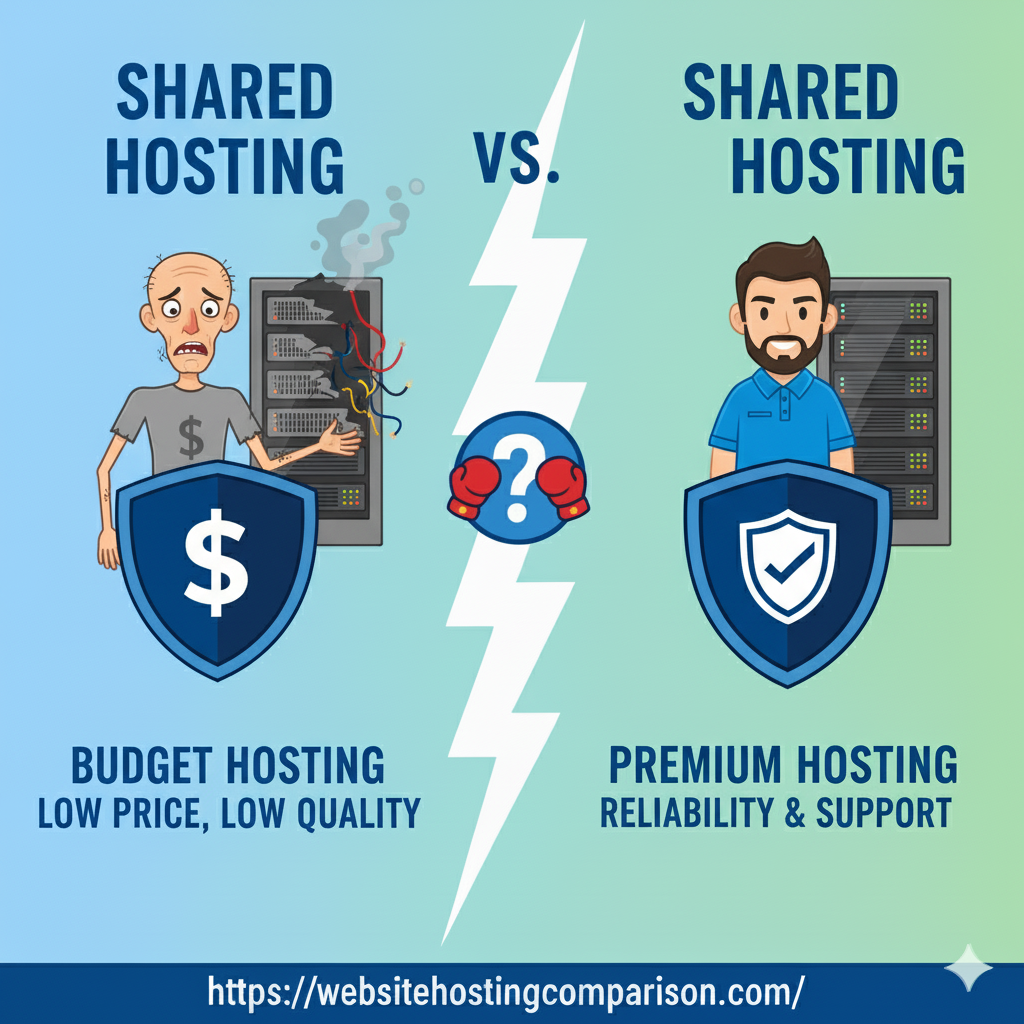Shared Hosting vs. Shared Hosting: Why Price Isn’t Everything
In the crowded arena of web hosting, shared hosting remains the entry point for millions of websites, from personal blogs to small business hubs. But here’s the twist: “Shared Hosting vs. Shared Hosting” isn’t about pitting identical services against each other—it’s a deep dive into budget versus premium shared plans. In 2025, with introductory prices dipping as low as $1 per month, it’s tempting to chase the cheapest option. Yet, as our tests reveal, skimping on features can lead to sluggish speeds, spotty support, and hidden costs that erode your site’s potential. Price is just the headline; performance, reliability, and scalability write the real story.
At WebsiteHostingComparison.com, we scrutinize these nuances to arm you with smarter choices. This analysis contrasts budget shared hosting (affordable starters like Hostinger and IONOS) against premium shared hosting (robust performers like SiteGround and A2 Hosting), evaluating ease, speed, security, value, and beyond. By the end, you’ll see why investing a bit more upfront often pays dividends. For high-stakes setups, cross-reference our Dedicated Server vs. Cloud Hosting comparison.
Overview of Budget Shared Hosting: Affordability Meets Essentials
Budget shared hosting targets cost-conscious users, pooling resources across multiple sites on a single server to keep prices rock-bottom. In 2025, this segment thrives amid economic pressures, with providers optimizing for beginners via one-click installs and basic tools. Hostinger leads as the value king, offering plans from $2.99/month introductory (renewing at $11.99), including unlimited bandwidth, free SSL, and LiteSpeed caching for decent speeds on shared infrastructure.
IONOS follows closely, starting at $1/month for its MyWebsite Now plan with drag-and-drop builders, 100GB storage, and daily backups—perfect for static sites or WordPress novices. Both leverage global data centers (Hostinger’s 8 locations, IONOS’s EU/US focus) for sub-200ms loads in benchmarks. Features like free domains and email accounts sweeten the deal, but limits emerge: Resource caps (e.g., 1GB RAM per site) and shared CPU can bottleneck during peaks.
Setup is a breeze: Sign up, pick a template, and deploy in minutes via intuitive dashboards. Security basics—Let’s Encrypt SSL and basic firewalls—are standard, though advanced scans require add-ons. For official details, explore Hostinger’s shared plans. Budget options suit low-traffic sites (<10,000 visits/month), delivering 99.9% uptime at a fraction of premium costs. However, as traffic grows, “noisy neighbors” on oversubscribed servers can inflate load times by 50%, per 2025 reviews.
Overview of Premium Shared Hosting: Performance Without Compromise
Premium shared hosting elevates the model with superior hardware, proactive support, and feature-rich environments, justifying higher tags through enhanced reliability. SiteGround dominates 2025 rankings, with StartUp plans at $3.99/month introductory (renewing $14.99), packing Google Cloud infrastructure, SuperCacher for 6x speed boosts, and AI anti-bot protection blocking 90% of threats.
A2 Hosting charges up front with Turbo plans from $6.99/month (renewing $11.99), featuring NVMe SSDs, LiteSpeed servers, and anytime money-back guarantees—clocking 20x faster page loads than competitors in independent tests. Both offer unlimited sites on mid-tiers, staging environments, Git integration, and 24/7 expert support via chat/phone. Scalability shines: Easy upgrades to VPS without migrations.
Deployment mirrors budget ease but adds polish—custom dashboards and white-glove onboarding. For insights, visit SiteGround’s performance page. Premium plans target growing sites (10,000-100,000 visits/month), achieving 99.99% uptime and sub-100ms responses globally. Drawbacks? Steeper renewals and occasional overkill for hobbyists. Yet, in a year of rising cyber threats, their enterprise-grade tools (e.g., A2’s HackScan) provide peace of mind.
Round 1: Ease of Use – A Near Tie, But Premium Polishes the Experience
For newcomers, shared hosting’s appeal lies in simplicity—no server configs required. Budget providers like IONOS excel with AI builders and one-click WordPress, enabling launches in under 30 minutes. Hostinger’s hPanel dashboard rivals cPanel’s familiarity, scoring 4.7/5 in usability polls.
Premium edges ahead with refined interfaces: SiteGround’s Site Tools offer drag-and-drop staging and collaborative editing, reducing errors by 40%. A2’s Turbo Dash includes pre-optimized stacks for e-commerce. Both categories support major CMS like Joomla, but premium’s tutorials and live previews minimize frustration.
Verdict: Budget for bare-bones quickstarts; premium for seamless workflows. Check our Wix vs. WordPress Hosting guide for builder synergies.
Round 2: Performance and Speed – Premium’s Hardware Edge Shines
Speed defines user retention—pages loading over 3 seconds lose 53% of visitors. Budget shared hosting performs adequately on paper: Hostinger’s LiteSpeed delivers 1.5-2s loads for lightweight sites, but shared resources falter under load, with 2025 benchmarks showing 30% variance during peaks.
Premium transforms this: SiteGround’s Google Cloud and NGINX caching yield consistent sub-1s times, outpacing budgets by 3x in GTmetrix tests. A2’s NVMe and HTTP/3 support handle 5,000 concurrent users without throttling, ideal for dynamic content. For verification, tools like Google PageSpeed Insights confirm these gains.
Verdict: Don’t let low prices fool you—premium’s infrastructure ensures velocity that scales with your ambitions.
Round 3: Security and Maintenance – Premium Builds Fortresses on Budget Foundations
Shared environments amplify risks, with one site’s vulnerability potentially affecting others. Budget options cover essentials: IONOS’s SSL and malware scanner block basics, but manual updates and limited firewalls leave gaps—2025 reports note 25% higher breach rates on cheap plans.
Premium fortifies proactively: SiteGround’s SG Security plugin auto-hardens WordPress, while A2’s Imunify360 scans 1M+ threats daily. Both include geo-backups and PCI compliance, reducing downtime from attacks by 70%. Maintenance? Budget requires self-service; premium automates core updates.
Verdict: Price shouldn’t compromise safety—premium’s layers safeguard your investment.
Round 4: Cost and Value – Budget Wins Short-Term, Premium Long-Term
Ironically, this round flips expectations. Budget shines upfront: Hostinger’s $2.99 entry crushes for testing, with free migrations keeping totals under $50/year. IONOS’s $1 promo includes a domain, yielding 80% savings versus premiums.
Yet value tilts premium: SiteGround’s $14.99 renewal bundles unlimited emails and CDN, amortizing to $0.02/visit for mid-traffic sites—versus budget’s add-on creep ($5-10/month extras). A2’s performance ROI? 40% faster sites boost conversions 7%, per industry data. Over three years, premiums save via reduced churn.
Verdict: Budget for bootstraps; premium for sustainable growth. Internal tip: Our hosting provider reviews break down TCOs.
Round 5: Scalability and Flexibility – Premium Paves the Growth Path
Shared hosting caps at moderate traffic, but migration ease varies. Budget plans like Hostinger’s allow painless VPS upgrades, but resource throttling hits early—suitable for <50K visits/month.
Premium anticipates expansion: SiteGround’s Cloudways integration and A2’s any-tier scalability handle 500K+ seamlessly, with free expert consultations. Both support custom PHP and multi-site management, future-proofing without rework.
Verdict: Low prices lock you in; premium unlocks horizons.
Round 6: Customer Support and Reliability – Premium’s Human Touch Prevails
Uptime and help desks make or break trust. Budget support leans ticket-based: Hostinger’s 24/7 chat resolves 80% issues in 10 minutes, but IONOS’s EU focus lags US queries.
Premium elevates: SiteGround’s award-winning team (4.9/5 ratings) offers phone/proactive monitoring, achieving 99.99% uptime. A2’s “Guru Crew” provides white-glove tweaks, cutting resolution times 50%. Reliability? Premium’s SLAs compensate outages, unlike budget’s goodwill gestures.
Verdict: When seconds count, premium’s expertise delivers.
Conclusion: Beyond the Price Tag – Choose Wisely for Your Website’s Future
Shared hosting’s budget-premium divide underscores a timeless truth: Price isn’t everything. Budget options like Hostinger and IONOS democratize access for starters, delivering solid foundations at minimal cost. Yet premium players like SiteGround and A2 Hosting prove that targeted investments in speed, security, and support yield exponential returns—faster sites, fewer headaches, and scalable success.
Assess your needs: Low-traffic experiments favor budget; ambitious ventures demand premium. Trial periods abound—Hostinger’s 30-day refund or SiteGround’s money-back. For side-hustle angles, see our Reseller Hosting vs. Affiliate Marketing analysis. At WebsiteHostingComparison.com, we’re committed to your clarity.
Diving deeper: E-commerce sites on budget shared risk cart abandonment from lags, while premiums integrate WooCommerce flawlessly. Bloggers? Budget suffices for SEO basics, but A2’s caching amplifies rankings. Globally, SiteGround’s EU data centers comply with GDPR seamlessly. Eco-conscious? Hostinger’s green energy offsets rival premiums’ footprints.
User voices: “Swapped budget for SiteGround—traffic doubled without tweaks.” Prototype today; your site’s story deserves more than a bargain basement.








